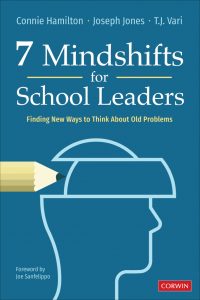
Leading Change
When we think of the most effective leaders of all time, we typically remember the people who had the greatest impact on culture. These are the people who have created or endured the most intense changes to life as we know it, whether that be in our organizations, school systems, country, or world. The definition of leadership is influence; the challenge of leadership is conflict; the result of leadership is change. Great leaders influence change by overcoming conflict.
But overcoming conflict is not just a price we must pay if we want to make change. It’s actually far more strategic than that. You can barrel through the resistance, but that rarely works in the long run. When we don’t follow a strict process for making change, we typically only see very incremental modifications to what we’re already doing rather than a full-scale innovation. We offer a 6-step model for leading change that works in any scenario where you plan to translate your idea from new to normal.
6-Step Leading Change Model for School Leaders
Clear Vision
This is a statement about what the future should look and feel like if our goals are met. Of course, every great organization has a vision statement; this is the same thing but it’s the vision for the change initiative, programmatic shift, or new cultural norm that we want to see in place. Vision statements should always answer three questions: what do we desire to accomplish; who do we want the work to benefit; and why does it matter?
Sample: We want all teachers to use collaborative structures so that our students learn to cooperate and communicate effectively as a college and career skill that they will need for their future success.
Core Values
These are our 3-5 guiding principles that ground the work. They should be inspirational, recitable, and action-oriented. Core values represent the behaviors associated with bringing the vision into reality.
Sample:
We value active participation in the classroom.
We value speaking & listening as a skill.
We value student voice as an agent of empowerment.
Enumerated Goals
These are the points of measurement, used to assess whether or not we are making gains toward the goal. Three important concepts should be noted: 1. They should not be endpoints but rather waypoints, 2. They should act as milemarks with the ability to measure progress not perfection, and 3. Even though SMART goals are touted as comprehensive, your goals only need to address what by when.
Sample:
- All teachers will use collaborative structures at least once per daily lesson.
- Our scheduled professional development time at faculty meetings will always include a demonstration of a new collaborative structure or a twist on one that we’re seeing in action (both in-person and remote).
- A sampling of lessons will demonstrate that 40-60% of the time is allocated for student-talk-time.
Research-based Methods
These are the critical practices that have demonstrated effectiveness through evidence and research in the field. As an instructional example, John Hattie, Robert Marzano, and others have published lists of effective instructional practices, including their corresponding effect size on learning outcomes. For any change initiative, the methods should be listed as success practices to be used in place of old norms and conditions.
Sample:
In the case of collaborative structures, we’re going to use Kagan as the basis for the practices that should be put in place.
Defined Focus
Once you develop a list of methods you want put in place, that list has to be narrowed to a defined focus. If you have a list of 10-15 practices, you might select anywhere between one and three to focus on for anywhere between one month and a year. As you monitor the focus, you’ll know when it has been mastered by everyone and a new focus can be put in its place. As you shift culture, the one-at-a-time approach works far better than expecting everything and everyone to just make the change.
Sample: RallyRobin and RallyCoach in September and October
Solid Models
This can be a visual representation of the focus items in a graphic format or even a list of checkpoints or steps for putting the focus into practice. We’re huge fans of visual models, like the one at the top of this post. That said, checklists and documented steps help people to see the process and take action versus the ambiguity in naming a practice that not everyone understands through practical application.
Sample:
Steps to implement a successful RallyRobin.
Changing culture is difficult. We always say that the number one thing that people don’t like is change. But, the number two thing that people don’t like is the way things are. Leading a change, whether it’s thrust upon you or initiated by you, is never easy but it doesn’t have to be complicated. When you couple the above change leadership model with a communication plan, you’ll find that change can happen faster and stick better than without it.
Stay tuned for challenges, nuggets of wisdom, reflection questions, technical tips, and the best resources for leading better and growing faster. Follow us at dereka206.sg-host.com to join thousands of leaders who get our alerts, blogs, podcasts, and more.
Let us know what you think of this #SH302 post with a like, a follow, or a comment. Find us on Twitter, YouTube, iTunes, Facebook, & SoundCould. And, again, if you want one simple model for leading better and growing faster per month, follow this blog by entering your email at the top right of the screen.
TheSchoolHouse302 is about getting to simple by maximizing effective research-based strategies that empower individuals to lead better and grow faster.






 7 Mindshifts for School Leaders: Finding New Ways to Think About Old Problems.
7 Mindshifts for School Leaders: Finding New Ways to Think About Old Problems. 


